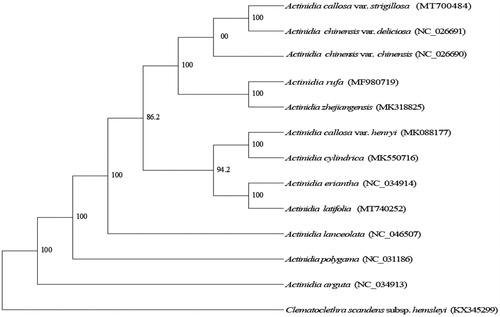Abstract
Actinidia latifolia, known for its high vitamin C content in fruits, is widely distributed in the subtropical and tropical regions of eastern and southern Asia. In this study, we sequenced the complete chloroplast (cp) genome sequence of A. latifolia to investigate its phylogenetic position in the gunus Actinidia. The complete cp genome sequence is 156,873 bp in length with 37.15% overall GC content and characterized by a typical quadripartite structure comprising one pair of inverted repeats (23,377 bp) separated by a small single-copy region (21,453 bp) and a large single-copy region (88,666 bp). The cp genome contains 132 unique genes, including 83 protein coding genes, 41 tRNA genes, and 8 rRNA genes. Phylogenetic analysis highly supported that A. latifolia evolutionarily close to A. eriantha.
Kiwifruit has long been recognized as ‘the king of fruits’ in China because its fruit has high Vitamin C contents and balanced mineral composition, dietary fiber and other metabolites that are beneficial to human health (Drummond Citation2013). Fruit of Actinidia species vary greatly in Vitamin C concentrations, from as low as 4–5 mg/100 g FW in fruit of A. henryi to over 1500 mg/100 g FW in A. latifolia (Latocha et al. Citation2010; Huang Citation2014). The high vitamin C and polyphenols contents in A. latifolia made better antioxidant capacity, which was about 3.3–8.7-fold higher than the commercialized kiwifruit Actinidia deliciosa cv. Hayward. A. latifolia is therefore an ideal species to study the nutritional contents in genus Actinidia, but up to now, the genome information is still less, and the chloroplast genome has not been reported. In this study, we sequenced and assembled the cp genome of A. latifolia for better understanding its cp genome information and phylogenetic information in genus Actinidia.
Here the samples of A. latifolia were collected from Nanling National Forest Park, Guangdong Province, China (24°55'N, 113°05E) and voucher was deposited in Herbarium of National Actinidia Germplasm Repository of China (Acs10028, NAGR, WBG-CN), Wuhan Botanical Garden, the Chinese Academy of Sciences. Total genomic DNA was extracted from fresh leaves of A. latifolia sampled in National Kiwifruit Germplasm Genebank of China, Wuhan Botanical Garden, the Chinese Academy of Sciences (30°33′48.6″ N, 114°25′1.2″ E). An Illumina pair-end (PE) genomic libraries of 600-bp and 180-bp insert were constructed by following the PE standard protocol (Illumina, USA) and sequenced using an Illumina Hiseq 2000 platform by NovoGene (Beijing, China). The raw sequencing data were filtered and trimmed by fastp program (Chen et al. Citation2018), and then fed into NOVOPlasty (Dierckxsens et al. Citation2017) for assembly using cp genome of A. chinensis as the reference (Yao et al. Citation2015). The annotation result was inspected using Geneious 11.0.4 software (Biomatters Limited, NZ;Matthew et al. 2012) and adjusted manually as needed. The annotated cp genome was submitted to GenBank under accession number MT740252.
The circular cp genome of A. latifolia was 1,56,873 bp (GC Content: 37.15%) in length, including a LSC region of 88,666 bp (GC Content: 35.67%), a SSC region of 21,453 bp (GC Content: 32.55%), and a pair of IR regions of 23,377 bp (GC Content: 46.55%). The GC content of A. latifolia cp genomes is similar to the reported A.eriantha cp genomes (Tang et al. Citation2019). The cp genome of A. latifolia encodes a total of 132 predicted functional genes, including 81 protein-coding genes, 30 tRNA genes, and 6 rRNA genes.
The phylogenetic analysis was conducted to analyze the phylogenetic position of A. latifolia in genus Actinida. Twelve complete chloroplast genome sequence of Actinidia species were aligned by MAFFT v.7 (Katoh and Standley Citation2013). The Maximum-Likelihood (ML) tree was constructed using MEGA 6.0 with 1000 bootstrap replicates (Swofford Citation2003). The result showed that A. latifolia is closely related to A.eriantha ().
Figure 1. Phylogenetic position of A. latifolia in genus Actinidia as inferred by MP analyses of chloroplast genome sequences. Numbers above the lines indicate the maximum likelihood bootstrap value >50% for each clade. Accession Numbers: A. callosa var. strigillosa (MT700484), A. chinensis var. chinensis (NC026690), A. chinensis var. deliciosa (NC026691), A. zhejiangensis (MK318825), A. rufa (MF980719), A. eriantha (NC034914), A. lanceolata (NC046507), A. callosa var. henryi (MK088177), A.cylindrica (MK550716), A. arguta (NC034913), A. polygama (NC031186), and Clematoclethra scandens subsp. hemsleyi (KX345299).

Disclosure statement
The authors report no declaration of interest. The authors alone are responsible for the content and writing of this article.
Data availability statement
The data that support the findings of this study are openly available in GenBank (accession numbers MT740252) at [https://www.ncbi.nlm.nih.gov/search/all/?term=MT740252].
Additional information
Funding
References
- Chen S, Yanqing Z, Yaru C, Jia G. 2018. fastp: An ultra-fast all-in-one FASTQ preprocessor. Bioinformatics. 34(17):i884–i890.
- Dierckxsens N, Mardulyn P, Smits G. 2017. NOVOPlasty: de novo assembly of organelle genomes from whole genome data. Nucleic Acids Res. 45(4):e18.
- Drummond L. 2013. The composition and nutritional value of kiwifruit. In: BP Moughan, editors. Advances in food and nutrition research, nutritional benefits of kiwifruit. Vol. 68. Waltham (MA): Elsevier Inc; p. 33–58.
- Huang H. 2014. The genus Actinidia, a world monograph. Beijing (China): Science Press.
- Katoh K, Standley DM. 2013. MAFFT multiple sequence alignment software version 7: improvements in performance and usability. Mol Biol Evol. 30(4):772–780.
- Latocha P, Krupa T, Wołosiak R, Worobiej E, Wilczak J. 2010. Antioxidant activity and chemical difference in fruit of different Actinidia sp. Int J Food Sci Nutr. 61(4):381–394.
- Matthew K, Richard M, Amy W, Steven SH, Matthew C, Shane S, Simon B, Alex C, Sidney M, Chris D. 2012. Geneious Basic: an integrated and extendable desktop software platform for the organization and analysis of sequence data. Bioinformatics. 28(12):1647–1649.
- Swofford DL. 2003. PAUP*. Phylogenetic analysis using parsimony (* and other methods), Version 4b 10. Sunderland (MA): Sinauer Associates.
- Tang P, Shen RN, He RW, Yao XH. 2019. The complete chloroplast genome sequence of Actinidia eriantha. Mitochondr DNA B. 4(2):2114–2115.
- Yao X, Tang P, Li Z, Li D, Liu Y, Huang H. 2015. The first complete chloroplast genome sequences in Actinidiaceae: genome structure and comparative analysis. PLoS One. 10(6):e0129347
